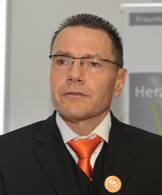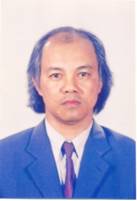| Liquid Crystal Polymer for Microwave and Millimeter-Wave Multi-layer Packages and Modules |
| By Prof. Anh-Vu Pham, University of California, Davis, USA |
|
Abstract |
Hermetic packages are used to protect microwave and millimeter-wave monolithic integrated circuits against harsh environmental conditions, including changes in atmospheric pressure, humidity, moisture, and other natural hazards that would otherwise disrupt electrical connections or damage delicate electronics. Microelectromechanical systems (MEMS) require hermetic packaging to prevent against contaminating particles and moisture. Hermetic packages have a fine helium leak rate of ~1x10 -11 atm-cc/sec and are known to provide the reliability in harsh environments. Current hermetic packages are based on metal and ceramic materials . Ceramic and metal packages are heavier, bulkier, and more expensive than organic counterparts. At the wafer-level packaging, high temperature wafer bonding is used to form hermetic cavities that result in tall structures. While organic packaging technology cannot provide true hermeticity, can it have a low enough leak rate to achieve competitive reliability? This is referred as “reliability without hermeticity” or near hermetic packaging. In this lecture, we will review the concept of hermeticity and near-hermeticity in electronic packages. Liquid Crystal Polymer (LCP), which has permeation close to glass, will be introduced as the next generation organic material for near-hermetic packaging. We will discuss results of LCP material characterization. We will then present the development of sealing techniques of LCP onto LCP and LCP onto semiconductor materials to form near hermetic cavities for housing MEMS and MMICs. Using the newly developed sealing techniques, we will demonstrate LCP wafer-level packages, surface mount packages and multi-chip modules to 40 GHz. Examples of wafer-level packages include the lamination of LCP onto Si to cap or package RF MEMS switches and a phase shifter with LCP-packaged MEMS. We will also present the development of low-loss surface mount LCP packages to 40 GHz. These surface mount packages are designed with novel feedthroughs that achieve a measured insertion loss of ~0.2 dB to 0.4dB up to 40 GHz and provide embedded filters. We will discuss bond wire compensation schemes, package to printed circuit board transition design techniques, electrical repeatability, and thermal performance of millimeter-wave surface mount packages. Reliability evaluation will be presented to demonstrate the robustness and reliability of LCP packages. Examples of the environmental tests include 1000 hours of 85 o C and 85% humidity, temperature cycles, thermal shock, etc. Finally, we demonstrate the development of compact wide bandwidth passive components, multi-chip modules, and phased array antennas in multi-layer LCP boards at Ka-band. |
About Speaker |
 |
|
Anh-Vu Pham (SM'03) received the B.E.E. (with highest honors), M.S., and Ph.D. degrees in electrical engineering from the Georgia Institute of Technology, Atlanta , in 1995, 1997, and 1999, respectively. Anh-Vu joined the University of California at Davis in 2002 as an Assistant Professor and is currently a Professor. From 1999 to 2002, he was an Assistant Professor at Clemson University . At UC Davis, Anh-Vu leads the Microwave Microsystems Lab, which has been supported by DARPA, NSF, AFRL and numerous companies for research on RF and millimeter-wave frequency organic packages and multi-chip modules, RF CMOS circuits, and wireless sensors. |
Recently, his group has focused on developing organic packages and modules that can provide hermeticity and reliability as ceramic counterparts. He has published ~100 peer-reviewed papers, several book chapters, and one book in print. Anh-Vu has served as the Chair of IEEE Microwave Theory and Techniques (MTT) Technical Coordinate Committee on Microwave and Millimeter Packaging (2003-2006), and is currently the Chair of IEEE International Microwave Symposium Technical Committee on Power Amplifiers and Integrated Devices. He received the National Science Foundation CAREER Award in 2001 and the 2008 Outstanding Young Engineer Award from the IEEE Microwave Theory and Techniques Society.
In 1997, Anh-Vu co-founded RF Solutions, a fabless semiconductor company providing RFICs for WiFi applications. In April 2003, Anadigics Inc. (NasdaqNM:ANAD) acquired RF Solutions. In 2008, he has co-founded Planarmag, Inc, a company specializing in electromagnetic components for data communications applications (Ethernet, DSL, etc) and serves as the CTO. |
|
Evolution from the Next Generation of Fixed and Mobile Networks
towards the Future Internet - Challenges and Approaches |
|
By Prof. Thomas Magedanz, Technical University of Berlin, Germany |
|
Abstract |
There is little doubt that the Internet of the Future will look
different from the existing Internet. However, in contrast to a radical
new and thus revolutionary internet design an evolution from the
existing internet will become of fundamental importance in order to
assure a proper transition of the existing business world. In addition,
it has to be recognized, that the Future Internet represents not only a
network of the future but rather a highly dynamic federated
communications platform interconnecting an open set of things
(machines), humans, data and services for realizing smarter
applications.
In this talk we want to look at the current network transition in the
fixed and mobile telecommunications world, i.e. the introduction of
all-IP based Next Generation Networks (NGNs) and emerging mobile
broadband networks. Here particular emphasis will be placed on the
introduction of Next Generation Mobile Networks and the related Evolved
Packet Core (EPC) providing a very flexible control platform for various
IP-based applications on top of LTE and many other broadband wireless
access network technologies. As currently no specific service platform
above EPC is being standardized (besides the IP Multimedia Subsystem for
voice services) a major question arising will be how to control and
coordinate interactions between the potentially numerous applications
and the underlying network(s). Also in the Future Internet one of the
key research topics currently addressed is the cross layer functional
composition, or better speaking, cross domain service composition, as
targeted by the G-Lab Project DEEP-G. Furthermore, as Next Generation of
Fixed and Mobile Networks will being deployed globally within the next
years, the issue of NGN to Future Internet evolution (NGN2FI) will
become of fundamental importance for the success of the Future Internet.
Thus we will look in this talk at the challenges and technical
approaches to address the cross domain service composition in NGNs and
the Future Internet and present an introduction of the related
activities performed within the joint NGN2FI Research Lab of Fraunhofer
FOKUS and TU Berlin
(www.fokus.fraunhofer.de/en/ngni/about_ngni/topics/future_internet/index.html), which are linked to various national and international Future
Internet research projects.
|
About Speaker |
 |
|
Thomas Magedanz (PhD) is full professor in the electrical engineering and computer sciences faculty at the Technische Universität Berlin, Germany, leading the chair for next generation networks (www.av.tu-berlin.de). In addition, he is director of the “next generation network infrastructure” division of the Fraunhofer Institute FOKUS (www.fokus.fraunhofer.de/go/ngni). In 2006, Prof Magedanz has been assigned as Extraordinary Professor at the Department of Electrical Engineering of the University of Cape Town, South Africa (www.ee.uct.ac.za).
Since more than 20 years Prof. Magedanz is working in the convergence field of fixed and mobile telecommunications, the internet and information technologies, which resulted in many international R&D projects centred around Next Generation Service Delivery Platforms prototyped in a set of globally recognised open technology testbeds provided to the international academia and industry. In 2007 Prof. Magedanz joined the European FIRE (Future Internet Research and Experimentation) Expert Group. |
In the course of his research activities he published more than 250 technical papers/articles. In addition, Prof Magedanz is senior member of the IEEE, and editorial board member of several journals. More details can be found at: http://www.fokus.fraunhofer.de/en/ngni/contact/team/tm.html |
|
Green Touch -- Limiting the ICT Carbon Footprint |
|
By Dr. C. Randy Giles, ED and President, Bell Labs Seoul, Alcatel-Lucent, South-Korea
|
|
Abstract |
Global modernization is straining the earth in ways that threaten man's long-term tenure on the planet. To avert the worst predictions, many industries, including the Information and Communications Technologies (ICT) sector, are obligated to transform themselves in fundamental ways.
In January, 2010, Alcatel-Lucent Bell Labs announced the Green Touch initiative and by February had together with leading industry, government, and academic members, founded a consortium with the goal to demonstrate by 2015 the technical feasibility of a 1000-fold increase in the energy efficiency of the world-wide ICT infrastructure. This talk will introduce the technical rationale of the Green Touch goal as currently understood and address the key challenges in limiting the carbon footprint of the underlying wireless and wireline networks of the ICT infrastructure.
|
About Speaker |
 |
|
Dr. Randy Giles is executive director and president of Bell Labs Seoul, which is focused on researching broadband services and its enabling technologies. Previously, Dr. Giles was director of the Optical Subsystems and Advanced Photonics department in Bell Labs at Alcatel-Lucent in New Jersey. Dr. Giles pioneered the modeling and use of erbium-doped fiber amplifiers for lightwave systems, demonstrated the first optical add/drop multiplexers by means of Bragg-grating technology and developed optical network applications of micromachines including scalable optical crossconnects and add/drop multiplexers. As a research director at Bell Labs, Dr. Giles led innovative programs in new optical network architectures, 100Gb/s transport technology, optical signal processing, and projector technology for mobile multimedia devices.
|
Dr. Giles is a graduate of the universities of Victoria (BSc Physics 1976, MSc Physics 1978) and Alberta (PhD Electrical Engineering 1983) in Canada. Before joining Bell Laboratories in 1986, Dr. Giles worked at Northern Telecom's research labs on their first gigabit optical transmission systems. Dr. Giles is a Fellow of the Optical Society of America and of Bell Laboratories and is a member of the US National Academy of Engineering. He was presented the Discover Award in 2000 for the invention of the MEMS-based optical crossconnect switch, and the Fraunhofer Award & Burley Prize from the OSA in 2004. Dr. Giles is a Laureate of the Millennium Technology Prize awarded in 2008 by the Finnish Government and he is the recipient of the 2010 John Tyndall Award from the OSA and the IEEE Photonics Society. |
|
Vietnam information and communication technology – a new age of development in the next decade |
|
By Dr. Pham Manh Lam, Vice President, National Institute of Information and Communications Strategy, Ministry of Information and Communications of Vietnam, Vietnam
|
|
Abstract |
Realizing the important role of information and communication technology (ICT) towards the country socio-economic development, Vietnam has tried the best to promote the development and use of ICT. In order to formulate the legislation framework for the development of ICT in the next decade, in 2009 the National Assembly promulgated the Telecommunications law, the Radio Frequency law and recently, the Ministry of Information and Communications has submitted to the government the strategy of ICT development in Vietnam to 2020. This talk will provide an overview of the c urrent status of ICT development in Vietnam . The main content of the Telecommunications law, the Radio Frequency law will be reviewed and the strategy for ICT development in Vietnam to the year 2020 will be presented as well.
|
About Speaker |
 |
|
Dr. Pham Manh Lam is currently the Vice President of the National Institute of Infromation and Communications Strategy (NIICS), Ministry of Information and Communications of Vietnam, where he was promoted from the Head of Department in 2006. He has been actively involved in formulating the strategy for Information and Communication Technology development in Vietnam . Prior to joining the Ministry of Information and Communications of Vietnam in 2003, Dr. Pham Manh Lam worked as a lecturer at the Department of Telecommunications, Faculty of Science and Technology in the Assumption University , Bangkok , Thailand (1999-2002).
Dr. Pham Manh Lam is trained as an engineer in telecommunications. He started off his career as a Research Assistant at the Department of Digital Techniques in the National Center for Natural Sciences and Technologies, Vietnam from 1984 to 1991. |
Dr. Pham Manh Lam graduated with a degree in Engineering from the Superior Industrial Institute of Tournai, Belgium , a Master and a Doctorate of Engineering in Telecommunications from the Asian Institute of Technology in Bangkok , Thailand .
|
|
|
Copyright © 2006, HUT-ICCE Biennial International Conference on Communications and Electronics
Powered by TMTSys 2.0 |
|
|

